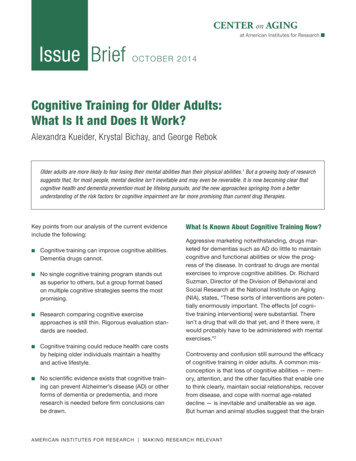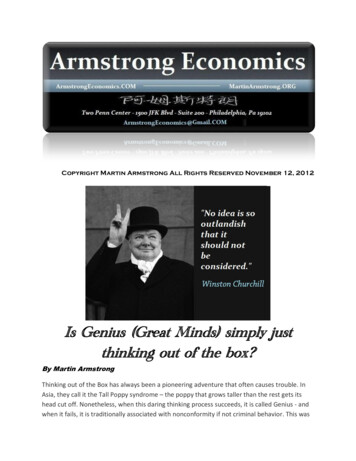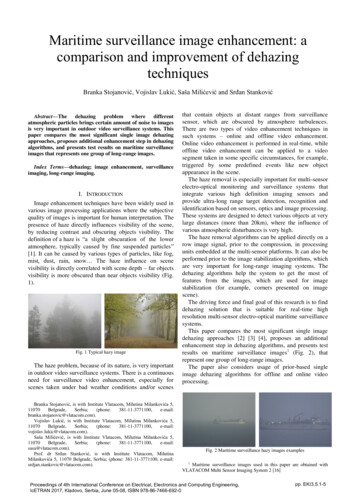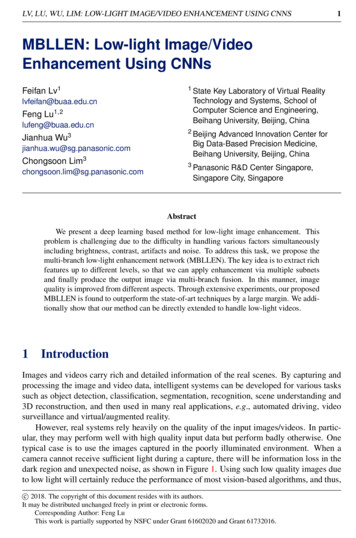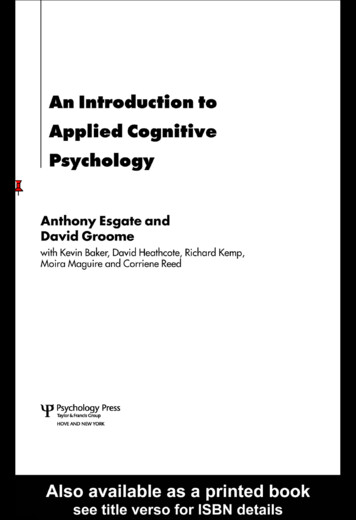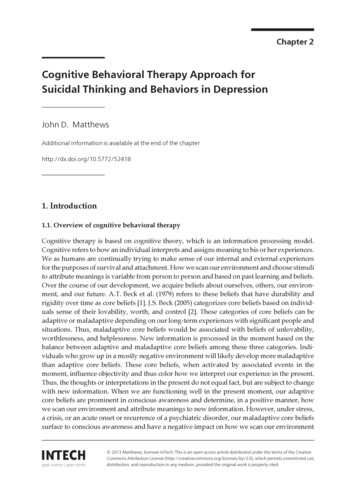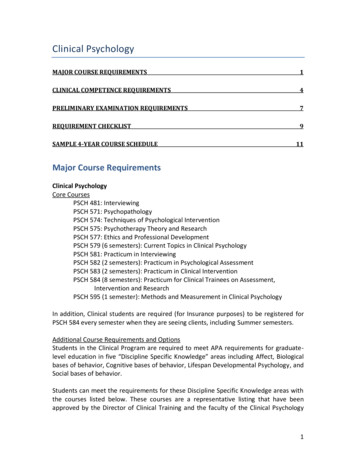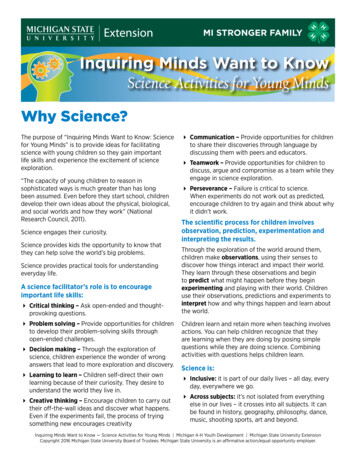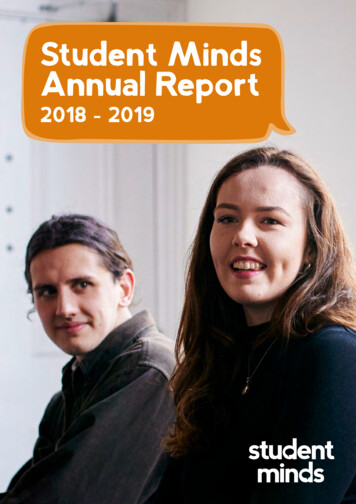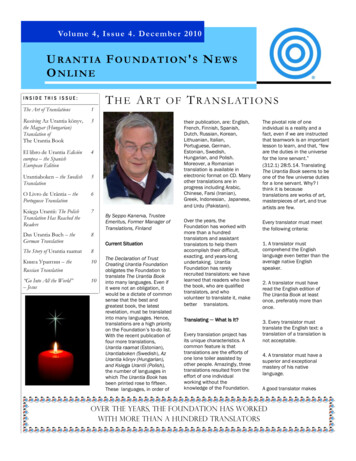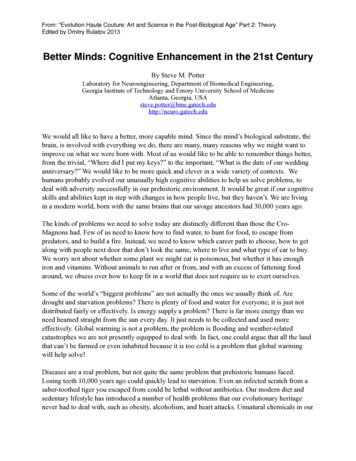
Transcription
From: “Evolution Haute Couture: Art and Science in the Post-Biological Age” Part 2: TheoryEdited by Dmitry Bulatov 2013Better Minds: Cognitive Enhancement in the 21st CenturyBy Steve M. PotterLaboratory for Neuroengineering, Department of Biomedical Engineering,Georgia Institute of Technology and Emory University School of MedicineAtlanta, Georgia, eduWe would all like to have a better, more capable mind. Since the mind’s biological substrate, thebrain, is involved with everything we do, there are many, many reasons why we might want toimprove on what we were born with. Most of us would like to be able to remember things better,from the trivial, “Where did I put my keys?” to the important, “What is the date of our weddinganniversary?” We would like to be more quick and clever in a wide variety of contexts. Wehumans probably evolved our unusually high cognitive abilities to help us solve problems, todeal with adversity successfully in our prehistoric environment. It would be great if our cognitiveskills and abilities kept in step with changes in how people live, but they haven’t. We are livingin a modern world, born with the same brains that our savage ancestors had 30,000 years ago.The kinds of problems we need to solve today are distinctly different than those the CroMagnons had. Few of us need to know how to find water, to hunt for food, to escape frompredators, and to build a fire. Instead, we need to know which career path to choose, how to getalong with people next door that don’t look the same, where to live and what type of car to buy.We worry not about whether some plant we might eat is poisonous, but whether it has enoughiron and vitamins. Without animals to run after or from, and with an excess of fattening foodaround, we obsess over how to keep fit in a world that does not require us to exert ourselves.Some of the world’s “biggest problems” are not actually the ones we usually think of. Aredrought and starvation problems? There is plenty of food and water for everyone; it is just notdistributed fairly or effectively. Is energy supply a problem? There is far more energy than weneed beamed straight from the sun every day. It just needs to be collected and used moreeffectively. Global warming is not a problem, the problem is flooding and weather-relatedcatastrophes we are not presently equipped to deal with. In fact, one could argue that all the landthat can’t be farmed or even inhabited because it is too cold is a problem that global warmingwill help solve!Diseases are a real problem, but not quite the same problem that prehistoric humans faced.Losing teeth 10,000 years ago could quickly lead to starvation. Even an infected scratch from asaber-toothed tiger you escaped from could be lethal without antibiotics. Our modern diet andsedentary lifestyle has introduced a number of health problems that our evolutionary heritagenever had to deal with, such as obesity, alcoholism, and heart attacks. Unnatural chemicals in our
levolutionhautecouture1!1CKyccTBO 111 HayKa B 3noxy nocT6111onor111111art and science in the post-biological ageCooasneHVIe VI o6ll\aR peAaKL\VIR ).:\MVITPVIR 5ynaTOBaEdited and curated by Dmitry UCMNCCAlocygapcTBeHHbl ljeHTp cospeMeHHOCO CKyCCTBa (IL\CVI)5am cK n an, Kan H Hrpag, 201 3National Centre for Contemporary Arts (NCCA)Baltic Branch, Kaliningrad, 201 3
CONTENTSINTRODUCTION010-0 1 7Dmitry BulatovA R T AND SC I ENC E AS THE CONJEC TUR E D POSS IBL EI. PATENT FOR LIFE:Doorway to the Post-Biological Culture020-037038-049Stephen W i l sonRoy Ascott050-063Pier Luigi CapucciISSUES IN THE INTEG RATION OF ART, SCIENCE AND TECHNOLOGYT H E TAO OF VA R IAB I L ITY:THE M U LTIPL E S EL F IN A M U LTIP L E R EA L ITYDECL INATIONS OF T H E L IVING: TOWA R D THE THI R D L I F EII. ARTIFICIAL BUT ACTUAL:Artificial Intelligence and Artificial Life066-083084-1 0 1Pa u l B rownJon McCo rmack1 02-1 1 9S i mon PennyNOTES TOWA RDS A HISTO R Y O F A R T, CO DE AND A UTONO MYEVOLUTIONA RY AND A - L I F E A RT CO S M IC P Y RA M I DSAND TH E O R IG INATION OF NOVELTY IN MAC H INESA R T A FTER COMPUTINGIll. LIMITS OF MODELING:Evolutionary Design and WearComp1 22- 1 35136- 1 53Ana ViseuSusan E l izabeth Ryan154-1 69La u ra BeloffW EA RCOMPS AND THE INFO R M E D INFO R MATIONAL BODYEMOTIONA L EXCHANGE: W EA RAB L E TEC HNOLOGYAS E MBO D I E D P RACTICETHE BODY IN POSSE: VI EWPOINTS ON W EA RAB L E TECHNOLOGYRoboticsJana Horakova1 88-2092 1 0-231D m it ry Gal kinLou is-P h i l ippe DemersROBOT AND KITSCH: F RO M THE MYTH OF TECHNOLOGICALP ROG RESS TOWA RDS T H E M E D I U M O F S UBVERSIVESTRATEG I ES OF POSTH U MANISMC YB E RNETIC ART IN THE 1 950s - 60s: ROBOTIC SCULPTU RESMAC H I N E P E R FO R M E R S NEITHER AG ENTIC NO R A UTO MATICV. BODY AS TECHNOLOGY:Techno-body Mod ification and Cyborgization234-249250-269270-287C hris Hables G rayErkki H u htamoStelarc304-319320-335338-3593 60-373374-385388-397398-4 1 34 1 4-427430-447IV. SHINING P ROSTHESES:172- 1 87290-303THE UNCANNY EVO LUTION OF HOMO CYBORGCYBORG IS A TOPOSF RACTA L F L E S H I L I M INA L DES I R E S:TH E CADAVER, T H E CO MATO S E AND T H E C H I M ERA448-4674 68-483486-4995 00-5 1 75 1 8-5 29532-55 1554-559
yVI. MODULATING A SIGNAL:From C ybernetics to Neuroengineering290-303Andrew PickeringBRAINS, SELVES AND SPIRITUALITY304-319Steve M. PotterBETTER MINDS COGNITIVE ENHANCEMENT IN THE 21sT CENTURY320-335Thomas S. RayFUTURE MINDS, MENTAL ORGANS, AND WAYS OF KNOWINGIN THE HISTORY OF CYBERNETICSVII. MORE THAN A COPY, LESS THAN NOTHINGNESS:Bio and Genetic E ngineering338-359Jens HauserTOWARD A PHENOMENOLOGICAL APPROACH TO ARTINVOLVING BIOTECHNOLOGY360-373Robert MitchellBIOART MEDIA, EVOLUTION, CULTURE374-385Konstantin BokhorovTHE PAINFUL SUPREMACY OF THE ETHICALVIII. SEMI-LIVING:Synthetic Biology and Tissue Engineering388-397Oron CattsSYNTHETIC CONTROL- (UN)LIMITED LIFE398-413lonat ZurrIN CONTINUOUS STATE OF SEMI-LIVING: A PARTIAL SURVEY414-427Melinda CooperTOPOLOGICAL ARCHITECTURE- TISSUE ENGINEERINGOF CONTEMPORARY ARTISTS WORKING WITH LIVING TISSUEAND THE PERMANENT EMBRYOGENESIS OF FORMIX. POST-SODOM AND POST-GOMOR RAH :From N ano to the Technological U nconsciousNANOARCHITECTURES: THE ARRIVAL430-447Luciana Parisi448-467Colin MilburnPOSTMORTEM: THE NECROSIS OF NANOTECHNOLOGY468-483Dmitry BulatovA NEW STATE OF THE LIVINGOF SYNTHETIC EXTENSIONS AND THOUGHTSX. RE-CODING:Differing from the Future486-499Joanna Zylinska'INVENTING WELL': CREATIVITY, BIOLOGY AND LIFE500-517Eugene ThackerEXOBIOLOGIES518-529Boris GroysIMMORTAL BODIES: COMMUNIST RESURRECTIONXI. APPEN DIX532-551BIOGRAPHIES554-559INDEX OF ILLUSTRATIONS
003EVOLUTION HAUTE COUTURE:ART AND SCIENCE IN THE POST-BIOLOGICAL AGEPa rt 2: Theory. Ed ited and cu rated by Dmitry Bulatov //560 pp. with 293 b/w ill, Kaliningrad: BB NCCA, 2 0 1 3ISBN 978-5-94620-073-8CreditsIdea and sci-art-composition: Dmitry BulatovEditor: Dmitry BulatovImage processing: A lexej ChebykinLayout Dmitry BulatovLogo: Pave l Save l ievDesign: O leg Blyablyas, J u ry Vasi lievCover i llustration: G a rnet HertzCopyed iting [rus]: Elena Ryabkova, Dmitry Bu latovCopyediting [engl]: Stephen Ankenman, Christian de LutzWe b site and P R: Sergey Sorokin, A leksandr F i rsovInternational Coordination CouncilRoy Ascott, P rofessor ofTechnoetic Art, The University of Plymouth, United KingdomDmitry Bulatov, C urator, The National Cent re for Contem porary Arts, Baltic Branch, K a l iningrad, RussiaPier Luigi Capucci, P rofessor of A rt, The NABA International Academy of Arts and Design, Milan, ItalyOron Catts, SymbioticA, The Centre of Excel lence in Biological A rts, T he University of Weste rn Austra l ia, Perth, Austra l i aKen Rinaldo, P rofessor of A r t and Technology, T h e O h io State Unive rsity, Colum bus, Ohio, USAEugene Thacker, P rofessor of Med i a Stud ies, T he New School, New York, NY, USATranslationsSte phen AnkenmanI rina BorisovaThomas Campbe l lIgor KhadikovAnna MatveevaSergej MikhailovAinsley MorseEugene Narys hkinKevin ReeseEkaterina ShamovaAnastasia S u l zhenkoEugene VolkovRealized byThe National Centre for Contemporary Arts(Baltic Branch, Russia)P.O.Box 1 582, Kaliningrad, 236000 Russiae-mail: videodoc.ncca-k a l iningrad.ruThe National Centre for Contemporary Arts (Baltic Branch, Kaliningrad, Russia) g ratef u l l y acknowledges the financial sup port of the Ministry of Culture of the Russian Federation (Moscow, Russia) 2 0 1 3 NCCA, Baltic Branch, Russia 20 1 3 Dmitry Bulatov and the contributors 2009 for video documentaries (Part 1 ) by the artists and thei r legal re presentativesDVD- ROM col lection is for p rivate home viewing only. Any unauthorized copying, h i ring, lending or public pe rformance is i l legaland s u bject to criminal prosecution.A l l rights reserved. T he t itle of the anthology, texts and i l l ustrations a re property of the National Cent re for Contem porary A rts(Baltic Branch, K a l iningrad, Russia) and the group of a uthors in accordance with the Copyright, Designs and Patents Act, 1 998.No part of this p u bl ication may be re produced, stored in a retrieval system or transmitted in any form or by any means, withoutthe prior written permission of the editor and the cont ributors. Exceptions a re a l l owed for brief announcements in newspapers,magazines, in rad i o shows and TV. Any violation of the Copyright, Designs and Patents Act is prosecuted.
005The National Centre for Contemporary Arts (Kaliningrad Branch, R ussia) and the author and compiler express their thanksfor the help given in the process of work on this project:The Museum of Modern A rt, New YorkThe ZKM Center for A rt and Media Karlsruhe, KarlsruheArs E lect ronica Festival, LinzVI DA: Art & Artificial Life Internationa l Awards, MadridThe Arts Catalyst, London and Z33, HasseltKIBLA - Association for C u l t u re and Education, MariborThe Ya maguchi Center for A rts and Media [YCAM), YamaguchiWith special thanks to:Irina AktuganovaLaura BeloffKsenia FedorovaReuben HaggettAleksandr KastornyAleksandra KosticAnastasija MaksimovaJu l ie MartinVictor MizianoManuela NaveauNatalia N ikitinVita ly PatsukovSi mon PennyPavel P h i l i ppovskyDmitry Pi l ikinRegine RappT i m o u r ShchoukineO l ga ShishkoA sya S h ishkovaKarl S i m sG erfried StockerB i l l VornI rina YurnaAnna ZajtsevaThe National Centre for Contemporary Arts (Kal iningrad, Russia) expresses its thanks to ArtBots: The Robot Talent Show (New York)specifical ly M r. Douglas Repetto; SymbioticA, The Centre of Excellence in Biological Arts at the School of Anatomy and H u man Biol ogy, UWA (Perth) particularly Dr. lonat Z urr for attention, f riendly care, and support given in t he process of work on this publ icat ion.Indiv idual thanks to M r. Leonid Bazanov and M r. M ikhail M in d l in for friendly care given in the process of work on the project, tostaff members of the NCCA, Moscow as well as to staff members of the BB NCCA for all of their help: Elena Tsvetaeva, EugenyUmansky, I rina Pokrant, Julia Bardoun, I rina Tchesnokova, Dani l Ak imov, Zinaida Schersch un, Vera Kazakova, Gal ina Kuzmich.The preparation of the project was made possib l e on a grant of an association "Kunstlerhaus Lukas e.V." that the author receivedin the framework of an internat ional artists exchange program between pa rtner organizations, the Baltic branch of the NationalCentre for Contemporary Arts (Kaliningrad, R ussia) and Kunst lerhaus Lukas A h renshoop (A h renshoop, Germany). The a uthorextends his sincere g ratitude to the team of the Kunstlerhaus Lukas and to the d i rector Gerlinde Creutzburg personally for coop eration and support in his work on the ant hology.Photo creditsThe editor wishes to thank copyright holders who great ly assisted in t his publication, including photographers or their repre sentatives, estates, agencies, foundations, and col lecting instit utions. Every effort was made to identify and contact individualcopyright holders; omissions are unintentional. The following are credits for copyrig hted material, l i sted by t he author's last name.Marina Abramovic' I Art Oriente Objet I (Art}ScienceBLR I Roy Ascott I James Auger and Jimmy Loizeau I Brandon Ballengee I Laura Beloff I Guy Ben-Ary I David Bowen IPaul Brown I Dmitry Bulatov I Pier Luigi Capucci I Oron Catts I Adrian David Cheok I Sonia Cillari I Laura Cinti I Cohen van Balen I Melinda Cooper I Carlos Corpa and AnaGarcia- Serrano I CAE / Tagny Daff I Ursula Damm I Joe Davis I Michel and Andre Decosterd I Wim Delvoye I Louis-Phi Iippe Demers I Stefan Doepner and Lars Vaupel IErwin Driessens and Maria Verstappen I Jalila Essaidi I Donna Franklin I Dmitry Gal kin I George Gessert I Ken Goldberg I Matthias Gommel I I sa Gordon I Andrew Gracie IPaul Gran jon I Chris Hables Gray I Boris Groys / Jens Hauser I Mateusz Herczka I Garnet Hertz / Kathy High I Adi Hoesle I Jana Horakova I Erkki Huhtamo I Hiroshi lshiguro IEduardo Kac I Dmitry Kawarga I Andy Keane I Matt Kenyon and Douglas Easterly I James King and Alexandra Daisy Ginsberg I David Kremers I Kuda begut sobaki I AlisonKudla I William Latham I Norene Leddy I Alvin Lucier I Lawrence Malstaf I Steve Mann I Benoit Maubrey I Jon McCormack I Marta de Menezes I Agnes Meyer-Brandis ISeiko Mikami I Colin Milburn I Robert Mitchell I Dmitry Morozov I Leonel Moura I Marnix de Nijs I Kira O'Reilly I Orlan I Luciana Parisi I Mark Pauline I Simon Penny I LeoPeschta I Andrew Pickering I Steve M. Potter I Lorenz Potthast I Helen Pynor and Peta Clancy / T homas S. Ray I Julia Reodica I Ken Rinaldo I Marcel.li Antunez Roca I PhilipRoss I Susan Elizabeth Ryan I Gordan Savicic I Karl Sims I Maja Smrekar I Christa Sommerer and Laurent Mignonneau I Sputniko! I Stelarc I Ivan Sutherland I J u n Takita IEugene Thacker I Paul Thomas / Timo Toots / Momoyo Torimitsu I Polona Tratnik/ Georg Tremmel and Shiho Fukuhara I Paul Vanouse I Kris Verdonck/Victoria Vesna I AnaViseu I Bill Vorn I Junji Watanabe I Jennifer Willet and Shawn Bailey I Stephen Wilson I Anouk Wipprecht I Doo Sung Yoo I Adam Zaretsky I lonat Zurr I Joanna Zylinska
Better Minds!Steve M. Potterfood and environment cause all sorts of diseases, from cancer to brain damage. And moderncompetitiveness causes chronic worrying and stress-related illness due to the unnaturallycontinuous activation of our sympathetic (fight-or-flight) nervous system. The good news is thatwe are much better at dealing with diseases than we were even two centuries ago. The bad newsis that they still cause much suffering and death.War is another real problem still causing suffering and death. Thanks to our tribal brains,countless lives and valuable resources continue to be wasted on fighting so-called enemies.Aggressive and defensive instincts that may have helped our ancestors in small tribes with scarceresources are maladaptive today. Feuds linger long past the relevance of their initial causes,whether between two neighbors, two gangs, two nationalities, or two races.Stop and consider: What would it take to solve the real problems facing modern humans today?It would take major changes in human nature. It would take a major update to our prehistoricbrain’s hardware and software. I propose that cognitive enhancement brought about byneuroengineering could make us better adapted to the modern world. It could quell ouraggression, allow us to appreciate all people, and help us devise new technology: for globaldistribution of food, water, and energy; for preventing diseases and accidents; for dealing withnatural disasters; for seeing both sides of every disagreement.Natural Cognitive EnhancementThere are (at least) two natural ways to enhance cognition, at very different time scales. Acrossgenerations, preferential survival and reproduction of the more clever members of the tribe haveresulted in the differences between us and the other Great Apes, i.e., a tremendous expansion ofour neocortex endowing us with the capacity for complex language and symbolic thought. It ispossible to speed up evolution. Farmers, pet owners and horticulturalists have been doing this forcenturies: selective breeding. It is unlikely that this approach will ever be popular for enhancinghuman intelligence. In fact, when modern medicine keeps alive a person who is about to die froma foolish accident or bad decision, and they go on to have offspring, the overall intelligence ofthe human gene pool is diminished. Thanks to medical advances, evolution is actually headingbackwards in some ways.On the shorter time scale of one lifetime, learning from others or from experience can make onewise and capable. Learning produces immediate results, and because everyone already uses thisform of cognitive enhancement, it will be comparatively easy to promote the idea of better andfaster learning through neurotechnology.Neurotechnology for Better LearningWhat is a thought? What is a memory? We know surprisingly little about such basic andfundamental aspects of our nervous system. Thousands of neuroscientists are working hardacross the globe to reveal the secrets of what is often described as the most complex thing we!2
Better Minds!Steve M. Potterknow of, the brain. In the Laboratory for Neuroengineering at Georgia Tech, 1 we are trying toadd a few pieces to the puzzle of how learning works, and how to improve it. As a model forhuman brains, we study simple nervous systems of a few thousand neurons and glial cells invitro. The Petri dishes we use have arrays of microelectrodes embedded under the cells, throughwhich we can deliver artificial sensory input to the neuronal networks cultured on them (Figure1). We can also record electrical activity patterns in these cultured neural networks, and try toFigure 1. Multi-electrode array Petri dish (left) with cultured network of a few thousand brain cells from a rat embryo,and 60 tiny electrodes (right).decode the patterns with powerful microscopes and computers.Hybrid Neural SystemsBy interfacing the cultured networks to robots or simulated animals, we can study their behavior,and try to induce changes that represent simple forms of learning. In the year 2000 at Caltech, wedeveloped the first hardware and software to “embody” cultured networks, to allow their activitypatterns to move robotic arms or wheels, and to translate data from the robots’ sensors intoelectrical stimulation patterns for the networks. One such hybrid robot, or “hybrot”, wasMEART, the Semi-living Artist. In collaboration with SymbioticA,2 we connected a roboticdrawing arm to cultured networks, sometimes thousands of miles apart, via the internet. Wehoped to induce learning in MEART’s living biological brain, by sending the culture dishstimulation based on what its video camera eye saw of the drawing in progress. Judging from thetypes of drawings MEART produced (Figure 2), it is not clear much learning was happening, butthe complexity of behavior produced by a network of even a few thousand brain cells s.uwa.edu.au/project.html!3
Better Minds!Steve M. PotterFigure 2. MEART, the Semi-Living Artist (left). Built by PhilipGamblen and Guy Ben-Ary, our collaborators in SymbioticA (U. ofWestern Australia, Perth). The pneumatically-driven pair of roboticdrawing arms were controlled by recorded activity patterns fromcultured neuronal networks in our lab in Atlanta. A webcam lookingdown at the drawing in progress sent back stimulation patterns,forming a closed-loop system whose body and brain were oftenthousands of miles apart. The drawings produced (right) changeddramatically from day to day, and culture to culture.surprising. Like a classroom full of preschoolers, each network we hooked up as MEART’s brainproduced its own unique style of scribbles.Learning in Embodied Cultured NetworksCultured neuronal networks, without a body and sense organs, are growing in sensorydeprivation. Like a person put into solitary confinement in a dark cell, they go crazy. Withoutnatural inputs, they develop activity patterns that resemble epileptic seizures, called networkbursts. During these bursts of activity, the neurons fire pathological signals in synchrony, whichmake it difficult for the hybrots’ sensory input to influence their behavior. We noticed that aculture that was being used to control MEART, after days of receiving stimulation fed back viathe internet from its video camera eye, began to calm down, showing less and less epileptiformactivity. We found we could quell the barrages of activity in all of our cultured networks bysprinkling low-frequency pulses of electricity across the network, delivered via the substrateelectrodes. In some sense, this restored the natural level of background activity to the culturednetworks, analogous to what an intact nervous system would receive from the animal’s senses.Thanks to the burst-quieting background stimulation, networks no longer exhibited continuousseizure-like activity, and they were more responsive to artificial sensory input. This, in turn,made them more amenable to studying learning and information processing in vitro.With the burst-quieting stimulation protocol, we were then able to reliably alter the behavior ofembodied cultured networks with artificial inputs. We used patterns of electrical impulses to train!4
Better Minds!Steve M. Pottera hybrot to navigate in a pre-specified direction. It was a simple task for a simulated animalcontrolled by a few thousand living brain cells, but a major advance for neuroscience. We nowhave a simple model biological system to study learning mechanisms, whose entire brain is laidout flat on a glass surface where one can easily watch it under the microscope while it is doingthe learning.Intact animals are used by many neuroscientists to study learning mechanisms, but theircomplexity makes it much harder to control all the variables in an experiment. Unlike behavinganimals, whose constantly moving brains are hard to image under the microscope, hybrots havesimple, stationary brains separated spatially from their robotic or computer-generated bodies. Inthe case of MEART, this separation was often thousands of miles. These experiments withembodied cultured networks have shown that an important aspect of the embodiment is for theneural-robotic system to be a closed loop. That is, the neural activity affects the robot’smovement, the movement affects the robot’s relation to its environment, the neuronal networkreceives new sensory input, and the sensory input then alters its neural activity, generating newmovements, and so on. By actively sensing and interacting with our environment, humans canlearn most effectively, and the same seems to be true for the hybrots.To close the loop between cultured networks and computers, we had to build our own customneural interfacing hardware and software. Others creating brain-computer interfaces for animalresearch closed the loop using natural sensory input via the animal’s own visual system, insteadof the electrical stimulation used to provide artificial sensory input to hybrots. The closed-loopneural interfacing technology we, and others have built for research purposes will help usunderstand basic mechanisms of learning and information processing in the brain, so we canbegin to look for ways to improve it. This technology will form the basis of future devicesdesigned to alter neural activity in humans, to enhance cognition in a variety of ways.Cyborgs Walk Among UsIn the brains of thousands of patients, electrodes have been implanted for clinical treatments anddiagnoses. Deep-brain stimulation (DBS) is being used to treat a number of neural disorders,such as Parkinson’s disease and chronic pain, and even cognitive problems including depression,memory problems, and obsessive-compulsive disorder. Such devices are the descendants ofpioneering research in the 50s by James Olds and Peter Milner, who found they could hijack thebrain’s natural reward circuits with electrical stimulation in certain regions, causing lab rats tobecome addicted to pressing levers to get small but intensely rewarding jolts of electricity.Because of the brain’s incredible complexity, researchers and clinicians are still mapping out theeffects of electrical stimulation of various brain circuits. The deep brain stimulators currentlyused are not much different from heart pacemakers, continually delivering pulses of electricity tonormalize activity in some malfunctioning circuit. They are not very sophisticated, with onlyfour electrodes, each one millimeter across, designed for stimulating but not recording neuralactivity. In contrast, the culture dishes we use in the Neurolab have 60 microelectrodes, eachonly 30 microns across (Figure 1), that can both record and stimulate with whatever complexstimuli we wish to deliver.!5
Better Minds!Steve M. PotterThe brain stimulators of tomorrow will, like our multi-electrode array culture dishes, have largearrays of microelectrodes for more delicate, finessed stimulation that is tailored to a person’sunique brain circuitry. Like our embodied cultured networks, they will be closed-loop, alwaysmonitoring ongoing neural activity and automatically adjusting their stimulation to meet thechanging needs that arise from a person’s varied activities and bodily states.It is not hard to imagine taking brain stimulation from the clinic to something used routinely bynormal people, to enhance their cognition. Like Olds’ rats, we might try to reinforce behaviorsthat are productive and helpful in the modern world, by well-timed stimulation of our rewardcircuitry after accomplishing something of merit. Of course, the same potential for addiction thatthe rats faced will be a problem, as well as the potential for powerful brainwashing or other“mind control” scenarios.By delivering complex patterned stimulation to the brain through arrays of microelectrodes, aswe now do routinely in our embodied cultured networks, we could artificially exercise or traincertain brain circuits. This might first be used to aid recovery from stroke or head trauma, bystrengthening weakened circuits, or re-mapping neural function to work around the damage.Michael Merzenich and others have demonstrated how plastic the cerebral cortex is, even inadults. They have developed therapeutic behavioral training video games that normalize signalprocessing in dyslexic children and improve memory in the aged.3 These computer programsrequire diligent effort, and constant attention to the training, to be successful. One can imagineactivating the same brain circuits, not through the eyes and ears, but via artificial stimulation.Once it becomes common and reliable to improve damaged brain circuits with electricalstimulation, it may be employed by normals to enhance their existing capabilities. Complex,patterned stimulation can serve as artificial sensory input, endowing us with new types of sensesor amplifying those we already have. Perhaps even information or new skills could be artificiallylearned, much faster or with less effort than the traditional way of learning by seeing, hearing,and doing.Micro-doses to Alter Brain ActivityThanks to the fact that part of neurons’ natural communication is electrical (the action potential),electrical stimulation has proven to be very useful for studying and influencing the brain, asdescribed above. But other components of neurons’ natural communication (neurotransmitters)are chemicals. Influencing brain function with chemicals is nothing new, especially in themodern world where caffeine, alcohol, and tobacco are ubiquitous. Advances such as closed-loopdrug delivery, like an insulin pump that injects insulin as a function of changing glucose levels,will allow more sophisticated control of brain function and enhancement.Present-day drugs for treating disorders of the brain are a blunt instrument. We may wish totarget only a tiny subset of the brain’s 100 billion neurons, yet all of them (and the entire body)3!http://www.scilearn.com/6
Better Minds!Steve M. Potterare bathed in the drug. Clever chemists are designing neuroactive pharmaceuticals with fewerside effects and better targeting, but the most effective drugs of the future will be those deliveredby devices implanted in the brain. These will release well-timed tiny doses only to the specificcircuits that we wish to influence. In fact, the brain itself is already wired to do this. There are anumber of modulatory brain regions that release minute but very effective amounts of anendogenous drug, such as dopamine, endorphins, or norepinephrine, onto very specific braincircuits to effect changes in their function. These are the neuromodulators that wake us up,change our mood, get us moving in an emergency, and help us remember important things.Neuro-active drugs of the future will be delivered in a similar manner, in small, well positioneddoses via microscopic devices implanted in the brain. As with electrical stimulation, this will bedone in closed-loop fashion, with the release of a drug being triggered by some physiologicalmeasurement, to ensure continually appropriate, personalized modulation of brain function. Theywill also be under some degree of voluntary control by the “implantee”.Magnetic Stimulation of the BrainBy sending magnetic pulses into the brain, its activity can be altered, in a similar fashion toelectrical stimulation, but without the need to implant anything. Trans-cranial magneticstimulation (TMS) is presently moving from being a research tool to a clinical treatment. TheTMS devices being used are cumbersome figure-8 coils of wire resembling big Mickey Mouseears when held behind a person’s head. They can only excite one brain region at a time, a fewmillimeters across. They cannot presently reach brain structures beneath the outer fewcentimeters of the
Ainsley Morse Eugene Naryshkin Kevin Reese Ekaterina Shamova Anastasia Sulzhenko Eugene Volkov e-mail: videodoc@ncca.koenig.ru www.ncca-kaliningrad.ru www.videodoc.ncca-kaliningrad.ru 003 The National Centre for Contemporary Arts (Baltic Branch, Kaliningrad, Russia) gratefully acknowledges the financial sup
